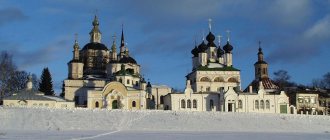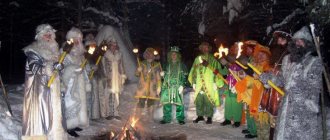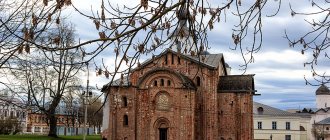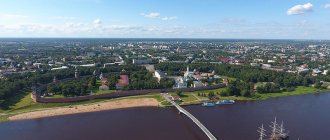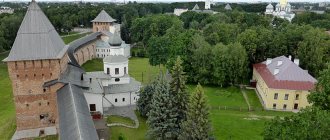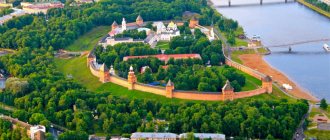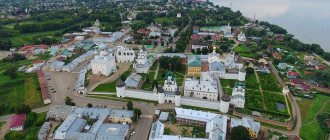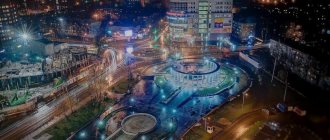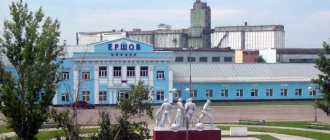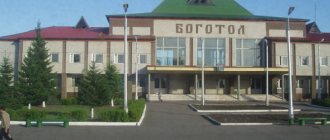The ancient city, founded on the banks of the Sukhona River back in 1207, is exactly the place where travelers who want not only to get a lot of vivid impressions, but also to understand the soul of the Russian North and feel its unique charm should go. The sights of Veliky Ustyug, photos and descriptions of which you will find in the article, are unique in many ways. The city has existed for more than 800 years, maintaining its amazing originality. Its coat of arms depicts the ancient god Neptune, and in a wonderful palace on one of the streets, Father Frost and the Snow Maiden are “registered”.
TOP-3 attractions of the city Veliky Ustyug
In addition to the stunning churches and cathedrals, which we will talk about separately, the city has several other symbols. You should see these iconic sights of Veliky Ustyug first.
Father Frost's estate
- Opening hours: daily, opening hours should be clarified by calling the contact phone number.
- Phone: +7 817 385‑21-10.
- Website: https://votchina-deda-moroza.ru
- Address: Mardengskoe settlement. It is better to get here by shuttle buses departing from the bus station 4 times a day or by taxi, paying about 200 rubles.
Having made a half-hour journey to the suburbs of Veliky Ustyug, you will find yourself in a world of wonders - the fabulous estate of Father Frost. First, guests will be invited to a magnificent tower, where the beloved folklore character lives with his eternally young granddaughter. Here, young and adult visitors will be shown the Throne Room, Gift Room, and Fairy Tale Storeroom. The excursion will continue with a visit to the Glacier, where Grandfather Frost lives in the hot summer. A walk through the Winter Garden, an island of the tropics inhabited by colorful exotic plants, will give a child a lot of impressions. And, of course, children will be able to ride on colorfully designed slides to their hearts’ content, and take part in competitions and quizzes organized by animators.
Monument to S. Dezhnev
- Address: Sovetsky Prospekt. Transport stop “Lunacharskogo Street”.
Semyon Dezhnev is perhaps the most famous native of Veliky Ustyug. Therefore, the monument to the great traveler and navigator, to whom many modern scientists give laurels as the discoverer of the Bering Strait, is especially revered by the townspeople. The stone statue of a Cossack chieftain is mounted on a cylindrical pedestal. On the pylon behind him there are bas-reliefs telling about episodes from the life and campaigns of Dezhnev, who made an invaluable contribution to Russian geographical science.
Factory "Northern mob"
- Opening hours: the exhibition hall is open on weekdays, from 10:00 to 15:00.
- Telephone.
- Website: https://www.sevchern.ru
- Address: st. Uglovskogo, 1. Transport stop "Northern Chern Factory".
The fame of the city of craftsmen has brought Veliky Ustyug real masterpieces made of precious metals, which have been created by local craftsmen for more than 300 years. Their creations amaze with their originality and inimitable finesse of work. Fine, blackened or gilded cutlery with the mark of the factory is extremely highly valued by art critics and has more than once received top awards at prestigious international exhibitions. The exposition of the exhibition hall presents the best creations of the successors of the glorious traditions of the ancient Russian craft, revived in the 30s of the last century by the famous master M. Chirkov.
See: TOP 30 attractions of the Vologda region
Amazing temples and churches
Connoisseurs of elegant architecture will receive great pleasure from visiting the stunning churches of Veliky Ustyug. Most of the churches built several centuries ago are in good condition, although they are not currently operational.
Assumption Cathedral
- Address: Sovetsky Prospekt, 62. Transport stop “Lunacharskogo Street”.
The Assumption Cathedral, consecrated in 1658, is one of the main attractions of Veliky Ustyug. The masterpiece of Russian architects has the traditional design for churches of the 17th century. cubic shape. The octagon of the main dome, like the graceful corner turrets, is topped with a gilded onion with crosses. The architecture of the two-part bell tower, which has a classic dome and a pointed hipped dome with a spire, is very interesting. The ashes of the high priests of the diocese rested in the crypt of the cathedral, and its walls were decorated with excellent frescoes, some of which have survived to this day. Currently, the temple, where restoration work is ongoing, can only be viewed from the outside.
Cathedral of Procopius the Righteous
- Opening hours: daily, from 8:00 to 19:00.
- Website: https://difo1975.cerkov.ru
- Address: st. Embankment, 57. Transport stop “Lunacharskogo Street”.
An excellent white-stone church with blackened domes, consecrated in 1668, was erected on the resting place of Procopius the Righteous, who lived in Veliky Ustyug and canonized by the Orthodox Church in the mid-16th century. Several miracles are attributed to the saint, whose sarcophagus with relics is kept in the temple. Today the cathedral is both a museum and a functioning church. Be sure to visit here and see the delightful carved iconostasis, again sparkling with gilding after restoration carried out in the last decade of the last century.
Ascension Church
- Address: Sovetsky Prospekt, 86. Transport stop “Lunacharskogo Street”.
The amazingly beautiful Church of the Ascension of the Lord, consecrated in 1648, is considered a true pearl of the city’s architecture. Once upon a time, the magnificent building, the exterior of which intricately intertwined the traditions of Byzantine and Old Russian architects, was decorated with 11 domes. The temple amazed contemporaries with the originality of its forms, the abundance of decorative elements, kokoshniks, carved rosettes, and the grace of figured drums. After a series of reconstructions, the church became five-domed, but by no means lost its originality and charm. Currently, restoration work is ongoing in the temple.
St. Nicholas Church
- Address: st. Embankment, 66. Transport stop “Lunacharskogo Street”.
An amazing temple in honor of St. Nicholas of Gostunsky, the patron saint of sailors, appeared in the city at the beginning of the 18th century, when the Sukhona River was still navigable, and Veliky Ustyug was considered a major port, as evidenced by Neptune, depicted on its coat of arms. The multi-tiered single-domed church, like the slender bell tower topped with a high spire, is a remarkable example of the unique Ustyug architecture of the Middle Ages. At the end of the last century, the temple was carefully restored and converted into an exhibition hall of the ethnography museum.
Trinity-Gledensky Monastery
- Address: Morozovitsa village, st. Central, 122.
To see this architectural miracle, which even in its current state never ceases to amaze, it is undoubtedly worth making the four-kilometer journey from the city to the village of Morozovitsa. Built in the 18th-19th centuries, the monastery complex impresses with the splendor of the Trinity and Tikhvin churches. The Holy and Northern Gates and the watchtower have survived to this day. Be sure to see the delightful four-tiered iconostasis of the Trinity Cathedral, which amazes with its exquisite carvings and unique wooden sculptures.
Museums, monuments and sculptures
Guests of this wonderful city will not have any problems with leisure activities. A traveler who comes here for the first time will find something to see in Veliky Ustyug while walking along the quiet streets, and tourists interested in history and culture will be attracted by the exhibitions of local museums.
Museum of Ancient Russian Art
- Opening hours: daily, except Mondays, from 10:00 to 18:00.
- Ticket price: adult 100 rubles, children 50 rubles.
- Phone: +7 817 382‑34-05.
- Website: https://www.ustyug-museum.ru/mus-icons
- Address: Sovetsky Prospekt, 84. Transport stop “Lunacharsky Street”.
The museum's exhibitions, of great interest to connoisseurs of filigree, black silver and enamel, are housed within the walls of the Ascension Church. During the excursion you will be able to get acquainted with magnificent collections of church utensils from the 15th-18th centuries, ancient jewelry, and excellent examples of artistic sewing. The pearls of the extensive collection of icons are the images of “Our Lady Hodegetria of Smolensk” and “The Canopy of the Royal Gates”. Experts consider the white stone Cross of St. Procopius to be the main value of the museum. Those interested are invited to take part in an icon painting master class and even try to paint an image with their own hands.
Museum of Local Lore
- Opening hours: daily, except Mondays, from 10:00 to 17:300.
- Ticket price: adult 100 rubles, children 50 rubles.
- Telephone.
- Website: https://www.ustyug-museum.ru
- Address: st. Embankment, 64. Sberbank transport stop.
Be sure to visit the wonderful museum of local history, founded in 1910. Its exhibitions can please art lovers who have seen a lot. A small collection of paintings includes paintings by V. Polenov, I. Aivazovsky, I. Shishkin, A. Vasnetsov. The collection of elegant products made from birch bark, made in the unique Shemogodsky style, is generally unique. In addition, the exhibition halls display ancient icons, church utensils, famous northern mobs, and artifacts found by archaeologists during excavations on the territory of a once prosperous merchant city.
Monument to Erofey Khabarov
- Address: Komsomolskaya Square. Transport stop “Lunacharskogo Street”.
Erofei Khabarov, another native of the Ustyug land, takes an honorable place among the outstanding explorers and pioneers of the Russian land next to Semyon Dezhnev. From his youth he began to engage in fur trading, in which he was very successful. Moving further and further to the East, Erofey Pavlovich discovered new lands rich in natural resources, carefully recording his impressions and drawing maps. Subsequently, his invaluable notes became the basis for mapping Transbaikalia and the Far East. It is no coincidence that the largest city on the Amur River is named after Khabarov.
Sculpture Aquarius
- Address: In front of the River Station building. Transport stop "Restaurant Ustyug".
Not far from Veliky Ustyug there is a confluence of the Yug and Sukhona rivers, giving rise to the main water artery of the northern European lands of Russia - the Northern Dvina. The original sculpture, installed on the city embankment in 1983, confirms the indisputability of this fact. An ancient demigod, leaning his knee on a boulder, pours together water from two open amphorae, symbolizing rivers. The words of a quatrain are engraved on the pedestal, poetically describing the birth of the Northern Dvina.
Shemogod birch bark carving
Opposite the post office is the Lad folk culture center. There they told us about the traditional Veliky Ustyug artistic craft - Shemogod carving.
From time immemorial, birch bark has occupied a special place in the life of the peasant. It was used everywhere - from building houses to making utensils, bast shoes and clothing. Over time, in the villages located along the banks of Shemogsa, a tributary of the Northern Dvina, peasants began to decorate their birch bark products with elaborate carvings. Traditionally, this trade was carried out by men: the winters were long, there was nothing to do - so they carved it slowly in the evenings under the light of a burning torch.
The Shemogod village of Kurovo-Navolok was famous for its particularly talented craftsmen, and the most skilled carver-artist was Ivan Veprev, a peasant of this village, who later founded an entire fishing dynasty. The products were so skillful that soon the fame of Veliky Ustyug “birch bark lace” spread throughout Russia, and then throughout Europe. This is how the craft received its own name - Shemogod carving.
Traditionally, caskets, boxes, boxes, dishes, plates and cigarette cases were decorated with such carvings. Traditional subjects were intertwined plant stems, flowers, and berries. They included images of birds and animals, and sometimes entire scenes - hunting, festivities and tea parties.
The fishing continues to this day, but now it is an exclusively female occupation. As before, everything is done exclusively by hand, no stamps are used. Therefore, each product is unique; no two are alike. It is believed that each master has his own handwriting, so he can easily distinguish his creation from others.
There are three traditional colors for the substrate: red, burgundy and green.
It usually takes from a week to two to produce a small tuesk from the photo above, and from a month to produce a large one.
Anyone can buy products from Shemogod craftsmen. Such a plate with an architectural motif costs 2,000 rubles. Simple ornaments are cheaper: about 1200.
The most suitable birch bark for fishing is taken during the “second sap flow,” that is, at the end of June, when rose hips bloom in these parts. Each tree has its own bark color: if a birch grows in a swamp, the shade will be darker, if in a dry place, it will be lighter. Before using birch bark for carving, it is allowed to mature. On average, this process lasts about a year, and its color can change arbitrarily - lighten or darken.
The master has two tools: a homemade sharp knife and a blunt awl. A design is applied to the birch bark with an awl, and the background is cut out with a knife.
Plan.
Fact.
Where to go with children in Veliky Ustyug?
The charming town will delight young travelers with wonderful surprises. Immersion in the world of fairy tales and miracles will bring the child many vivid, memorable impressions.
Museum of New Year's Toys
- Opening hours: from Tuesday to Saturday inclusive, from 10:00 to 18:00. Lunch break from 12:00 to 13:00.
- Ticket price: adult 100 rubles, children 50 rubles.
- Telephone.
- Website: https://www.ustyug-museum.ru
- Address: Communy Square, 7. Transport stop "River School".
The unique museum is housed in the building of the now defunct Church of the Myrrh-Bearing Women, an architectural monument of the 18th century. Its exhibits include various New Year's decorations: from Bethlehem stars and porcelain angels, which our grandparents decorated Christmas trees with, to glass and plastic holiday accessories that are common today. Colorful toys made of cotton wool, wood or clay, chic garlands, figures of the Snow Maiden and Santa Claus, elegant tips are incredibly colorful. Inspecting the exhibition will delight your beloved child.
Zoo in the estate of Father Frost
- Opening hours: daily, opening hours should be clarified by calling the contact phone number.
- Phone: +7 817 385‑21-10.
- Website: https://votchina-deda-moroza.ru
- Address: Mardengskoe settlement, territory of the estate of Father Frost.
One of the main attractions of the Estate of Father Frost is a small zoo, founded in 2009. The spacious enclosures built on an area of 7 hectares contain about 50 species of animals and birds. Here you will see moose, deer, foxes, wolves, brown bears, eagle owls, owls, and other representatives of the fauna of the Russian North. Children will be able to play with some animals. Those interested are offered a ride on a sled pulled by huskies.
Residence of Father Frost
- Opening hours: daily, on weekdays from 9:00 to 18:00, on weekends from 10:00 to 18:00.
- Phone: +.
- Website: https://www.pochta-dm.ru
- Address: Oktyabrsky Lane, 1A. Transport stop “Lunacharskogo Street”.
In addition to the delightful country estate in a fabulous forest, Father Frost also has a residence in Veliky Ustyug itself. The elegant historic mansion houses a post office, which receives millions of letters from young Russians every year. During the excursion, children will be told about how magic mail works, taught how to correctly format messages to Santa Claus, and shown a magnificent collection of New Year's postcards, including rarities from the beginning of the last century.
Father Frost's estate
Twenty years ago in Veliky Ustyug no one had even heard of Father Frost: previously no one had given much thought to the geographical habitat of this fabulous old man, and old fairy tales shed no light on this matter at all. The project “Veliky Ustyug - the birthplace of Father Frost” was invented in the crisis year of 1998 by the then mayor of Moscow Yuri Luzhkov. While passing through the nearby village of Morozovitsa, he asked: “Why Morozovitsa? Isn’t this the birthplace of Father Frost?”
In December of the following year, at the recreation center of the Novatorsky timber industry enterprise, Father Frost received the first guests in his new mansion. Rumor has it that the first “grandfather” was a former electrician from that same timber industry enterprise.
Twenty years have passed. Now the patrimony of Father Frost is a huge tourist complex. There seems to be everything here: a blacksmith shop, a carpentry workshop, a zoo, a greenhouse, and even a forest pharmacy (apparently, in case someone suddenly gets sick - a child from the abundance of entertainment, or his parent from the amount of money spent).
The heart of the complex is the huge tower of Father Frost. Next to it, as the main holiday tree, is a plastic cone decorated with garlands. At this very moment the fairy tale begins to burst at the seams.
The inside of the tower: scary boxes of white split systems and a wall rotted from the flowing water.
The fairy tale is over, welcome to the real world!
You can stay on the territory of the estate in a hotel or in separate cottages. There is also a restaurant, several cafes and a cheese factory where they produce Ragusanio, filotti and other caciotta. Prices for local cheese, by the way, are very reasonable: in the range of 600-700 rubles per kilogram, which is quite comparable to what we usually sell under the guise of cheese in chain stores.
Thanks to our hotel partner TVIL.RU, we lived in one of the separate cottages. It belonged to a tourist company.
The cottage consisted of two floors: several bedrooms, a spacious kitchen-dining room and a basement in which billiards and table tennis tables were hidden. I spent a good half of the night behind one of them, actively swinging my racket.
In one of the rooms there was a modest sign hanging on the wall.
A fabulous morning arrived and we, having loaded ourselves with absolutely fabulous sandwiches, went to meet Santa Claus.
The path to becoming a wizard is not easy.
First, you need to walk along the “Trail of Fairy Tales”: chat with fairy-tale characters, dance, complete a number of competitions and solve a number of riddles.
Whether long or short, all the tasks were completed, and we found ourselves in front of the tower.
Now we had to visit all his rooms, and there are twelve of them, and get acquainted with the old man’s personal belongings - pillows, fur coats, books and a newfangled selfie stick. In the process, we learned that Santa Claus has his own coat of arms and standard, and that in the mansion you can even hold a ceremony for the newlyweds (the wedding night is not included in the list of entertainment).
The last test was waiting in line. Time fled. The line didn't move.
Finally, we were invited. Santa Claus turned out to be a two-meter giant with tired eyes.
We quickly exchanged a few words with him, took a photo, after which grandfather conveyed his warm greetings to the Belarusian Dzed Maroz and the Finnish Joulupukki, whom I had met earlier.
We went to have tea. The head of the Veliky Ustyug region, Alexander Kuzmin, came to greet the members of the expedition. Santa Claus treated us to honey and pine cone jam and lamented: “You upset me that you came without a family and without children.” After all, our families are our most precious, greatest wealth. Take care of your family and friends, never call on the phone, but visit each other.
In response, I said that I was also upset: plastic cones instead of live Christmas trees are no good! Santa Claus promised me that someday a real fluffy spruce would grow next to the tower, and I promised to come with my family next time. That’s what they decided on (the author of the photo with the tea party is Sasha Safronov).
Finally, Santa Claus threw out Balabanov’s “Well, if you love honey, love the cold!”, tapped his staff, adjusted his crown and went outside to communicate with the children who had come to visit him.
And we went to the glacier to look at “all the beauty of the sparkling north” collected there.
What can I say: the patrimony of Father Frost is an excellent example of how to create tourism brands from scratch. The entire history of the development of this project is an adventure in its purest form, on the one hand, and a consequence of the periodic presence of political will, on the other.
The transport accessibility of Veliky Ustyug in 1999 was practically zero: the construction of a bridge across the Northern Dvina, through which you can now easily get to Kotlas, was then virtually frozen, the road from Vologda was in extremely poor condition, and the local airport was breathing its last, receiving only a couple of flights a week. In fact, it was possible to get to the city only by rail: in a trailer car to the Moscow-Vorkuta train, for which it was not so easy to get tickets, or by train, which at that time connected Veliky Ustyug with Yadrikha railway station on the route "Vologda - Kotlas".
Nowadays, there are roads - the journey from Kotlas takes no more than an hour, and from Vologda - no more than five; and they promise to reconstruct the airport by next fall; and in winter, special tourist trains run from St. Petersburg and Moscow to the estate of Father Frost.
If in 1999 no more than two thousand tourists visited Veliky Ustyug, then in 2022 - already more than three hundred thousand. And 99% of this is precisely the merit of the estate. It seems that this is success.
But this coin also has a flip side: the artificially synthesized patrimony of Father Frost in ancient Veliky Ustyug is like a plastic double-glazed window in a hundred-year-old wooden merchant’s house: the result seems to be there, but if you look more closely, everything is somehow wrong. This project is exclusively about money, this is clear from the first minute. And the magic here is like in a shopping center: humming air conditioners on the walls and boorish two-meter-tall security guards driving children away from the old man in his mansion. Like that will do. But when the patrimony was just in its infancy, any child could call from home in Veliky Ustyug in the evening and personally talk to Santa Claus...
— Adult bloggers have arrived here, give them a fairy tale. What's wrong with artificial Christmas trees? Here on Palace Square in St. Petersburg - also before the New Year, a plastic cone is installed...
The bad thing about this story is that there is no sincerity in it: the patrimony of Santa Claus is a conveyor belt for pumping out money, which, by the way, works almost perfectly. To the question - what prevents us from doing everything really well, with attention to detail, the project is all-Russian, and there is clearly money here - there is no answer.
Finally, I cannot help but say that behind the scenes of the estate, Shakespearean passions have been in full swing for many years: the tourist center is quite a tasty morsel, and there is a real struggle for its possession. This year, this story reached its climax: the old team was fired, and the complex got a new owner. According to the official version, all these changes are related to improving the management system and optimizing costs; according to local residents, this is a regular raider takeover.
The development plans of the new owners are truly Napoleonic: over the next five years, an amusement park, a cinema, a water park and a spa complex should appear on the territory of the estate. Maybe they will finally plant a real Christmas tree.
